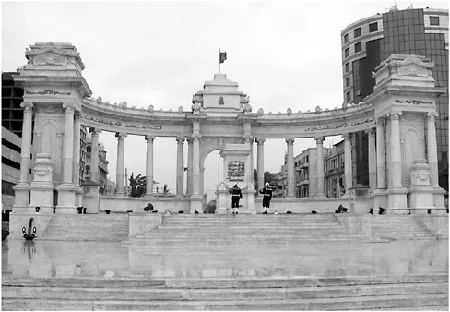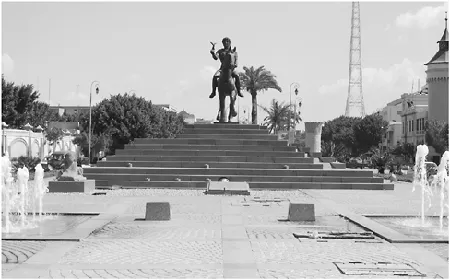![]()
Part I
Colonial anxieties and cosmopolitan desires
![]()
2
Literary Alexandria
A tale of two statues
In 1938 the Italian community of Alexandria officially presented the city with a gift to celebrate the close relationship that existed between Italy and Egypt. The gift, a statue of the Khedive Isma‘il, specifically commemorated the state visit of his son, King Fu’ad, to Italy in 1927—the first official trip of his reign.1 The installation of the statue affected a repatriation of sorts for the exiled ruler—after Isma’il was deposed in 1879 he initially settled in Italy.2 The Italian community of Alexandria had a particular fondness for Isma‘il and his Italian-educated son, Fu’ad. Although Isma‘il’s grand vision for the reconstruction of Cairo was inspired by Haussmann’s Paris, the Khedive showed a particular taste for Italian arts during his reign. He hired Italian architects and he commissioned an opera by Giuseppe Verdi to mark the opening of the Opera House during the celebrations that inaugurated the Suez Canal in 1869. Although the commissioned work, Aida, famously did not premiere in Cairo at the inauguration, the first performance featured another Verdi opera, Rigoletto.3
Consistent with Isma‘il’s reputation as a modernizer and Westernizer, the statue was placed in the heart of Alexandria’s commercial center, adjacent to Manshiyah Square between the French Gardens and the sea. Elevated on a marble plinth, the statue was backed by a grandiose semi-circular marble colonnade in the idiom of Italian fascist architecture.4 The statue stood with its back to the statue of Mehmed Ali on the other end of the French Gardens, which Isma‘il himself had commissioned in 1868.5 Isma‘il’s likeness faced instead toward the Mediterranean, to symbolize “Egypt turned toward the West.”6
The unveiling of the statue by the Italian community of Alexandria had originally been set for 1935, during Fu’ad’s reign, but was postponed because of the Italo–Ethiopian war.7 The delay of the unveiling was unfortunate. Fu’ad died in 1936, so his son and successor, King Farouk, was the ruler present at the statue’s dedication.8 More significantly, between the original planned inauguration in 1935 and the unveiling in 1938, the Italian community in Alexandria—of which a significant proportion were Jewish9—had undergone a series of divisive shocks, particularly Italy’s 1936 pact with Germany and its implementation of anti-Semitic laws in 1938.10 Anouchka Lazarev notes that the timing of the gift intended to celebrate the symbiosis between Egypt and Europe is additionally steeped in irony; a year earlier the Montreux convention had repealed the Capitulations that underpinned the system of privileges granted to European residents of Egypt and set a timetable for the abolition of the Mixed Courts that Isma‘il had implemented during his reign.11
In 1966, 14 years after the Free Officer’s Revolt deposed the last of the hereditary line of rulers from which Isma‘il issued, his statue was removed from its plinth. In contrast to the Italians’ rosy view of the Khedive, Egyptian nationalists recall Isma‘il’s financial ineptitude, which brought about Egypt’s increasing dependence on the West. When Isma‘il ascended to power in 1863, he inherited an internationally financed national debt of three million pounds that the treasury had accrued under his predecessor Sa‘id to finance the construction on the Suez Canal. During his reign, Isma‘il continued borrowing from European financiers. In 1875, to avert a bankruptcy crisis, Isma‘il sold Egypt’s shares of the Suez Canal Company to the British government. This act drew Great Britain into Egypt’s financial affairs, and is considered a stepping stone to British domination of Egypt. Isma‘il was deposed by the Ottoman Sultan in 1879 under pressure from the British and French governments. Three years later Great Britain asserted its desired control by invading Egypt and holding the country under military occupation.
It is not uncommon, of course, for revolutionary regimes to topple the statues of former rulers. However, the fate of Isma‘il’s statue could be said to encapsulate not just the changing ideologies of the state, but also the changing perception of the country’s cosmopolitan past. In the years between the fall of the monarchy and the removal of Isma‘il’s statue, the majority of Egypt’s foreign minority communities had emigrated. According to the refigured national narrative of the new regime, Alexandria’s cosmopolitanism was equated with the excesses of the bad old days of foreign domination. From the renaming of streets to the removal of statues of discredited former rulers, Alexandria’s public face was made to conform to the new ideologies of the state. Institutions, monuments, and buildings that reflected the colonial-cosmopolitan era were neglected.12 Alexandria was transformed from cosmopolis to regional capital. The foreign minorities who had once resided in Alexandria, if recalled at all, were cast as compradors to colonial interests.
Once the statue was removed, the plinth and colonnade were recycled into a national monument more in keeping with the new ideologies of state—the tomb of the Unknown Naval Soldier (Figure 2.1).13 As Benedict Anderson asserts, “no more arresting emblems of the modern culture of nationalism exists than cenotaphs and tombs of Unknown Soldiers.”14 Both monuments—the statue and the memorial—represent articulations of nationalism and visions of the nation. Representing a former ruler, the statue stood not only as a reminder of the nation’s history, but also reflected a vision of the nation that accepted the multiple affiliations represented by the Italian Alexandrian community. The tomb, by contrast, privileges military memorialization over civilian memory—patriotism over pluralism.
For 32 years, Isma‘il’s statue sat unceremoniously on the grounds of the Husayn Subhi Museum of Fine Arts in Alexandria. In 1998, at the initiative of the newly appointed governor of Alexandria, ‘Abd al-Salam Mahjub, the statue of Isma‘il
was re-installed in central Alexandria.15 The reappearance of the statue is not an anachronistic expression of royalist sympathies, but rather an act of restoring honor to the past—royal, colonial and cosmopolitan—that must be understood in the context of the transformation Alexandria experienced in the late 1990s.
Following the change in leadership of the Alexandria Governate in 1997, and in preparation for the opening of the Bibliotheca Alexandrina, the city underwent a facelift. Much of the renovation effort was aimed at restoring the built environment of the colonial cosmopolitan era, and recuperating the look, if not the feel, of Alexandria’s modern cosmopolitan past.16 These efforts were in part motivated by the city’s desire to transform itself into a tourist destination. Lacking the dramatic ancient artifacts of Giza and Luxor, Alexandria has pinned its marketing effort on nostalgia for the lost cosmopolitan past—anchored by the library on the one hand, and the literary city of E. M. Forster, C. P. Cavafy, and Lawrence Durrell on the other. Isma‘il’s statue represents a cosmopolitan era artifact. Although it was too politically explosive to return the statue to its original place, its restoration reflects the Governate’s interest in returning visibility to Alexandria’s cosmopolitan past.
In 1999, one year after Isma‘il’s statue was re-installed, the remaining Greek community of Egypt, in conjunction with the Egyptian Greek diaspora and the Greek Patriarchate of Alexandria, presented the city with a statue of Alexander the Great mounted on his horse Boucephalus.17 The Governate commissioned a local architect committed to the preservation and revitalization of Alexandria’s cosmopolitan past, Mohammed Awad, to design and landscape the square in which it was to be placed.
The plan raised the hackles of a number of public figures, spurring a debate in the newspapers. Some objected to the installation of the statue on the basis that Alexander was, in effect, the harbinger of “foreign rule” that had dominated Egypt, in one form or another, until the 1952 revolution. Even more galling was that the statue of Alexander was to be placed in a square previously named for a national military hero, ‘Abd al-Mun‘im Riyad. Riyad, a Lieutenant General, who served in the 1948 and 1967 Arab Israeli wars as well as the 1956 Suez conflict, was killed in combat during the War of Attrition with Israel. One journalist summed up the opposition to the proposed square in his newspaper column: “Isn’t it enough that the entire city bears Alexander’s name even though he was a conqueror and an imperialist? Wouldn’t it be more proper to install a statue of an Egyptian hero like ‘Abd al-Mun‘im Riyad or even of an Egyptian writer, thinker, literary personality or artist?”18
Once the statue of Alexander had been installed, there was further dissent. The designers of the plaza included two artifacts from the collection of the Greco-Roman Museum in Alexandria—a column and a small sphinx. Together these relics were intended to represent the cultures unified under the Ptolemaic dynasty founded by Alexander’s leading general. The sphinx was placed on a low, polished granite slab in front of the elevated platform upon which the statue of Alexander sits, while the column stands behind the statue to the right (Figure 2.2). The unveiling of the layout once again incensed opponents who saw Alexander’s horse poised to step on the sphinx—the foreign conqueror trampling on their Egyptian heritage.19
In the aftermath of the public outcry, Riyad, whose name was already affixed to streets or squares in many Egyptian cities, was honored with his own statue in the square named after him in Cairo, a major transportation hub in the shadow of elevated highways and a tangle of ramps situated behind the Egyptian Museum (Figure 2.3). Riyad’s statue in Cairo was dedicated in July 2002 during a week of national celebrations marking the 50th anniversary of the Revolution. The statue of Alexander was officially dedicated in October 2002 in conjunction with the festivities surrounding the opening of the Bibliotheca Alexandrina. The inauguration of each of these statues of military men represents a distinct act of memorialization that reflects its own vision of the nation’s past. The statue of Riyad, not unlike the Tomb of the Unknown Naval Soldier, valorizes the modern military from whose ranks Egyptian presidents have emerged since 1952. The statue of Alexander, like the Bibliotheca Alexandrina, reflects a desire to recuperate memories of the city’s cosmopolitan past.
While the opposition to Alexander’s statue and its placement explicitly addresses the Macedonian’s legacy as both conqueror and founder, the debate also implicitly resists a belated act by the dwindling Egyptian Greek community to inscribe itself on the public face of the city. The dispute also signals that Egypt’s cosmopolitan past remains contested on the grounds of its implicit colonial legacy. The narratives of this past, despite the official revival of interest in the cosmopolitan built
environment, continue to pose a challenge to the integrity of the Egyptian national imaginary.
In this chapter I map the depiction of Alexandria in literature to understand the multiple, often conflicting valences attached to Alexandria’s cosmopolitan past. I begin by briefly discussing the myth of cosmopolitan Alexandria perpetuated by literature in Western languages from Plutarch to Lawrence Durrell. Many literary works about cosmopolitan Alexandria in European languages are unmoored from the physical spaces of Alexandria and detached from the realities of the Egyptians living there. As Robert Mabro notes, one would get the impression from this literature that the city was almost exclusively populated by foreigners and the occasional Westernized Copt or Egyptian Jew, even though Egyptians significantly outnumbered foreigners in the city throughout the entire period.20
In the second section, I turn my attention to the representation of Alexandria in Egyptian Arabic cultural production. This literary Alexandria contributes to the formation of the Egyptian national imaginary—initially reflecting the pluralist idiom of the day, and later affecting a nationalization and domestication of ...


